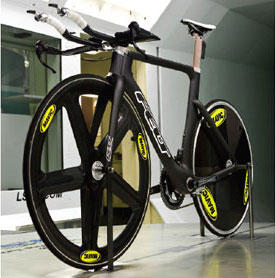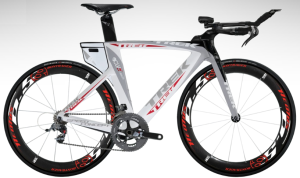
Tunnel testing is becoming a more important part of what we cover these days. Maybe, as we have for races, we ought to build a live coverage engine for these tests! We'll be writing about two more tests over the next couple of weeks, and our editor-in-chief is at one of them as we publish this.
The Cervelo test is the most interesting to me, because, as in the case with Trek's test last year, this test does not consist of a set of athletes aboard bikes, rather it's bike-versus-bike: a superbike showdown.
Cervelo is famous for its DZ Mannequin. Unlike the biological DZ, the faithful Mannequin has never left the Cervelo stable only to return.
DZ animated—Dave Zabriskie—is back aboard a Cervelo via his Garmin Cervelo team, and the 56cm P4 tested here is built in the position in which he ride—The DZ mannequin sitting aboard the P4 in DZ's actual position. The test we're covering here was performed with the following bikes all set up in DZ's position, and in the following sizes:
– Cervélo P4 Evo, size 56 cm
– Giant Trinity Advanced SL, size medium
– Specialized Shiv, size medium
– Trek Speed Concept, size medium
– Scott Plasma3 Premium, size small

Best Native Config
The P3 and the P4 don't always, or even typically, "win" wind tunnel tests (the P4 did however "win" this one, as you'll read) and I have a theory as to one reason why this happens. Note that for this test the Speed Concept chosen was of a size that granted each bike equal "stack," that is to say, the bikes for purposes of positioning were of equal height. Because the Cervelo is a longer bike than the Speed Concept—when normalized for stack, as these bikes were—the Speed Concept would have to have a longer stem placed on the bike to normalize each bike for the DZ position.
But if you normalized bikes for reach—if you tested bikes in sizes that were of the same length, rather than the same height—then you'd end up with a Cervelo in a size that is quite small. What do you do with a bike like that, to normalize for a standardized rider position? You either place spacers under the stem, or you put a steeply-angled stem on the Cervelo, pointing to the sky.
It's natural for a bike company to want to choose a position that favors that bike's "best native configuration" which will call for a flat stem, no spacers, and so forth. I suspect Cervelo, frankly, gets routinely hosed when its frames get "normalized", not through intent, rather because of Cervelo's low front ends compared to those of certain other companies.
Best Cervelo Config
How did Cervelo do in choosing a neutral front end or, at least, choosing bike sizes and spec that made the test fair?
Overall it did well, but it might've chosen certain bike sizes differently. For example, As we saw in the case of the Speed Concept, Cervelo chose bikes that were of the same height. However, Cervelo placed aboard its P4 a 3T Ventus aerobar (pictured just below). This bar features armrests that sit about 5cm to 6cm above the centerline of the stem clamp (or, where the stem clamp would be if there was a stem in this integrated bar).

Speed Concept 9-Series bikes are built with an integrated Bontrager bar, the pads of which sit fairly low compared to the pads on the Ventus. As a consequence the Speed Concept chosen was built with a stem in the upward—rather than flat or downward—config. The bike also appears slightly on the tight side, cockpit-wise. I might've chosen a Speed Concept in the next size up. I think the animate DZ would more likely ride a size-L, with a reach to match the 56cm P4's reach, and a flatter front-end.
Were the other bikes that were subjects of this test represented in their most appropriate sizes? I guess that's open to interpretation. For example, it's been my observation that Shivs and Trinity Advanced bikes are often ridden by their sponsored pros in sizes smaller than those I'd have chosen, with armrests pedestaled to reach their required heights. I'd prefer to see these bikes ridden in taller sizes. In the case of the Shiv, a bit of pedestal was used. Cervelo had no choice, as the Shiv's sizes are not scaled, rather simply lengthened (all the sizes have the same stack).
In the case of the Trinity Advanced, there was no pedestal under the armrest, and I think this is the size I'd have chosen. The Plasma Premium, I'd have sized up. This, because the bike was impossibly narrow for the DZ dummy. Cervelo wrote: In order to match Cervélo’s wind tunnel testing mannequin fit coordinates, the Scott Plasma3’s stock 90mm stem was replaced with a 110mm 3T stem. Modeling clay was applied to the 3T stem to match and complete the surfaces and features of the original Scott stem as closely as possible.
So, in my estimate, the Plasma 3 in size-medium would have been a better choice than a size-small, and a Shiv in size-large would have been better than a size-medium. Now, before you exhort me to pick size-M or size-L and stick with one or t'other, note in our stack and reach tables that Plasmas in M are almost exact geometric duplicates of Transitions in L, and Plasmas in S are identical to Transitions in M.

Note, however, that these flatter stems for the Premiums—often shown on pics of the Plasma TT—may or may not be obtainable, or readily available, on the Plasma Premium (pictured at right). The flat stem on the larger-size Premium would be a requirement to attain the DZ Dummy's fit coordinates. Therefore, it may well be that Cervelo used the frame, and with a stem, that is commercially available.
Identical components?
Wheels, tires, cranks, brakes, were idential for all bikes tested. The one difference was in aerobars. The P4 was tested with 3T's Ventus, and the other bikes were tested with the bars that come native on them. This is appropriate for the other bikes, because most superbikes built these days are built with integrated, proprietary bars.
Is the Ventus a fair choice for comparison? It's a mighty aerodynamic bar, specifically as regards the pursuit position where, when the DZ Dummy's elbows are in the cups, the wind doesn't much notice anything outboard of its shoulders.
Were a more "normal" bar used, how different would the test have been? We don't know. Still, there's no law against buying a Ventus and sticking it on your bike—I bought one and stuck it on mine. This is one selling feature of a P4: You can place the bar of your choice on it.
Our Cop on the Beat
We have two regular, always-in-attendance, F.I.S.T. instructors at our tri bike fit workshops: Jordan Rapp and J.T. Lyons. As J.T.'s retail bike store—Moment Cyclesport in San Diego—resides about a mile from the San Diego Air & Space Wind Tunnel, he served in the capacity of "wind tunnel cop," making sure from our perspective that everything done at this test was fair to the bikes of all companies tested. J.T. was there every minute of every hour of every day, watching, measuring, recording.
Test Results
Below are the results of the test. Readers will note that Cervelo's P4 did variously well, or very well, versus those in its competive set, depending on the yaw angle and on the specific config.






Conclusions
Note that the P4 fared best inside a narrower yaw band: inside of 7.5° of yaw either way. The Plasma was occasionally slightly better at wider yaws, up to 15°, and the Speed Concept and Shiv were right in there with the P4 at these larger yaws.
The graph most interesting to me was "DZ on, Fastest Bottle Config." This, because, were I to ride a superbike (other than the P4) I would certainly not place a bottle on its down tube, rather, between the aerobars. This was the specific test not done; therefore the closest approximation was this particular config.
Still, it is assumed that a bottle between the aerobars would produce some drag, unless the bottle itself acted as a fairing. My guess is that, in most cases, such a bottle is a source of drag rather than a mitigator of it.
The P4's bottle placement comes with a plus and a minus. Its placement enhances the overall control and handling of the bike, by both lowering the bike's center of mass and placing it rearward of the bike's steering axis.
The minus is the lack of an ability to drink from the bottle directly, while in the aero position, absent using a system rigged to drink directly from the P4's frame bottle without leaving the aero position.
But I'm not a fan of such systems, and my own guess is that I'd use the P4's bottle not as a water container, rather like the Speed Concept's Speed Box, and I'd keep my spares, inflators, tools, in the P4's "water bottle." Then I'd revert to a between-the-aerobars drink system, which is quite compatible with 3T's Ventus bar used for the test (I've got my own homemade drink system that I've use on a P3 + Ventus).
Other bike companies might argue that the superior straight-on performance of the P4 is: 1) Somewhat due to the superior 0° yaw performance of the Ventus (the minimal drag of the pursuit position seems intuitively to be optimized for straight-ahead winds; and, 2) The most important yaw angles are those between 7.5° and 15°. As to the latter point, that's above my pay grade.
What is nevertheless undeniable, based on the results of this test, is that the P4 is the equal, or near equal, of every other bike in the test at these greater yaws, and better yet when as the bike points directly into the wind.
This is the first article on Slowtwitch to be published about this test; more will follow.


